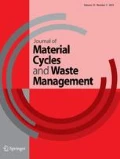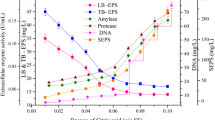Abstract
Coagulation–flocculation is a process commonly applied to treat many types of industrial wastewater. However, chemicals used in a wastewater treatment plant, including coagulants/flocculants, are costly. This study evaluated the feasibility of recycling the chemical sludge of the Mobarakeh Steel Complex (MSC), and using it as a coagulant aid in the process of wastewater treatment. The experiments were conducted in a jar test apparatus in consecutive cycles by adding a fraction of the settled sludge to samples. The response surface methodology (RSM) was employed to design the experiments and optimize the process. The response in the RSM model was residual turbidity, and the factors affecting the response included the sludge recycle ratio and return sludge cycle number. The sludge volume index (SVI) of the chemical sludge was also examined in each cycle of the tests to assess the sludge quality. The results revealed that recycling the sludge reduced the use of chemicals up to 60%. Finally, it was concluded that flocculation sludge could be considered as an alternative to chemicals, without adversely affecting the removal efficiency. Furthermore, SVI results showed that an increase in the number of cycles led to a decrease in SVI in each cycle, resulting in sludge volume reduction, better dewatering, and decreased sludge treatment costs.








Similar content being viewed by others
References
Chang YS, Kim JH, Murugesan K, Kim YM, Kim EJ, Jeon JR (2009) Use of grape seed and its natural polyphenol extracts as a natural organic coagulant for removal of cationic dyes. Chemosphere 77:1090–1098. https://doi.org/10.1016/j.chemosphere.2009.08.036
Guan XH, Chen GH, Shang C (2005) Re-use of water treatment works sludge to enhance particulate pollutant removal from sewage. Water Res 39:3433–3440. https://doi.org/10.1016/j.watres.2004.07.033
Chu W (2001) Dye removal from textile dye wastewater using recycled alum sludge. Water Res 35:3147–3152. https://doi.org/10.1016/S0043-1354(01)00015-X
Babatunde AO, Zhao YQ (2007) Constructive approaches towards water treatment works sludge management: an international review of beneficial re-uses. Crit Rev Environ Sci Technol 37:129–164. https://doi.org/10.1080/10643380600776239
Chu W (1999) Lead metal removal by recycled alum sludge. Water Res 33(13):3019–3025
Basibuyuk M, Kalat DG (2004) The use of waterworks sludge for the treatment of vegetable oil refinery industry wastewater. Environ Technol 25(3):373–380. https://doi.org/10.1080/09593330409355471
Jangkorn S, Kuhakaew S, Theantanoo S, Klinla-Or H, Sriwiriyarat T (2011) Evaluation of reusing alum sludge for the coagulation of industrial wastewater containing mixed anionic surfactants. J Environ Sci 23(4):587–594. https://doi.org/10.1016/S1001-0742(10)60451-2
Zhou Z, Yang Y, Li X, Wang W, Wu Y, Wang C, Luo J (2014) Coagulation performance and flocs characteristics of recycling pre-sonicated condensate sludge for low-turbidity surface water treatment. Sep Purif Technol 123:1–8. https://doi.org/10.1016/j.seppur.2013.12.001
Nair AT, Ahammed MM (2015) The reuse of water treatment sludge as a coagulant for post-treatment of UASB reactor treating urban wastewater. J Clean Prod 96:272–281. https://doi.org/10.1016/j.jclepro.2013.12.037
Ravikumar K, Krishnan S, Ramalingam S, Balu K (2007) Optimization of process variables by the application of response surface methodology for dye removal using a novel adsorbent. Dyes Pigment 72:66–74. https://doi.org/10.1016/j.dyepig.2005.07.018
Xu Y, Chen T, Cui F, Shi W (2016) Effect of reused alum-humic-flocs on coagulation performance and floc characteristics formed by aluminum salt coagulants in humic-acid water. Chem Eng J 287:225–232. https://doi.org/10.1016/j.cej.2015.11.017
Su Z, Li X, Yang Y (2017) Recycling ferric water treatment sludge (Fe-WTS) as coagulation aid: a case study in residual aluminum control. Desalin Water Treat 72:119–125. https://doi.org/10.5004/dwt.2017.0202
Foroughi M, Chavoshi S, Bagheri M, Yetilmezsoy K, Samadi MT (2018) Alum-based sludge (AbS) recycling for turbidity removal in drinking water treatment: an insight into statistical, technical, and health-related standpoints. J Mater Cycles Waste Manage 20(4):1999–2017. https://doi.org/10.1007/s10163-018-0746-1
Mazari L, Abdessemed D, Szymczyk A (2018) Evaluating reuse of alum sludge as coagulant for tertiary wastewater treatment. J Environ Eng 144(12):04018119. https://doi.org/10.1061/(ASCE)EE.1943-7870.0001462
ASTM (American Society for Testing and Materials) (2008) Standard D2035, In: Annual Book of ASTM Standards: General Products, Chemical Specialties, and End Use Products. ASTM International, Pennsylvania, USA
Eaton AD, Clesceri LS, Franson MAH, Rice EW, Greenberg AE (eds) Water Environmental Federation (WEF), and the American Public Health Association (APHA) (2005) Standard methods for the examination of water and wastewater. American Public Health Association (APHA), Washington
Montgomery DC (2010) Design and Analysis of Experiments, 7th edn. Wiley India Pvt. Ltd, New Delhi
Myers RH, Montgomery DC, Anderson-Cook CM (2009) Response surface methodology: process and product optimization using designed experiments, 2nd edn. Wiley, New York
Anderson MJ, Whitcomb PJ (2005) RSM simplified. Productivity Press, New York. https://doi.org/10.4324/9781482293777
State-Ease, Inc. (2015) Design Expert Software, Version 9, User's Guide
Mołczan M, Wolska M, Szerzyna S, Żółtowska M, Wiśniewski J, Adamski W (2018) Comparative studies of coagulation in a batch and continuous mode systems. Arch Environ Prot 44(3)
Author information
Authors and Affiliations
Corresponding author
Additional information
Publisher's Note
Springer Nature remains neutral with regard to jurisdictional claims in published maps and institutional affiliations.
Rights and permissions
About this article
Cite this article
Taheriyoun, M., Memaripour, A. & Nazari-Sharabian, M. Using recycled chemical sludge as a coagulant aid in chemical wastewater treatment in Mobarakeh Steel Complex. J Mater Cycles Waste Manag 22, 745–756 (2020). https://doi.org/10.1007/s10163-019-00966-7
Received:
Accepted:
Published:
Issue Date:
DOI: https://doi.org/10.1007/s10163-019-00966-7




